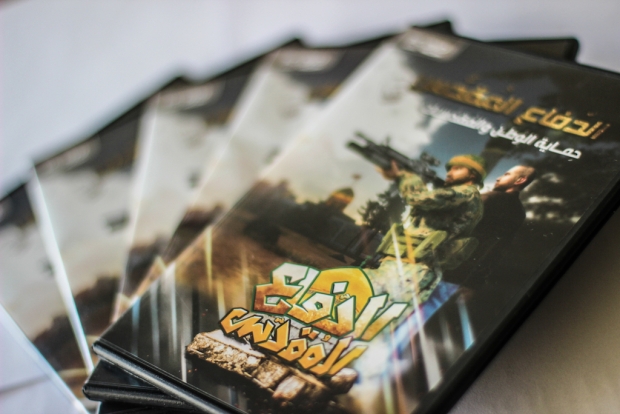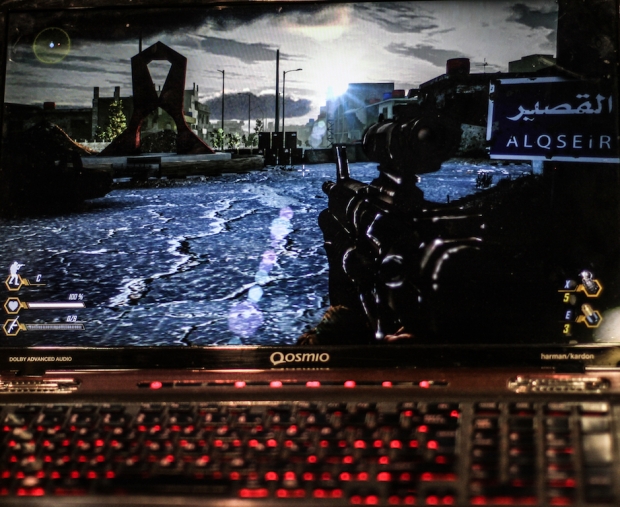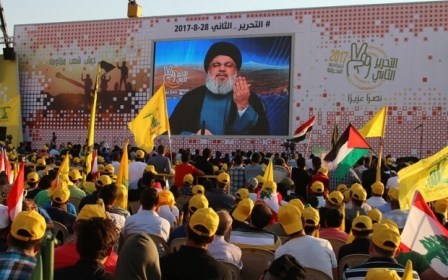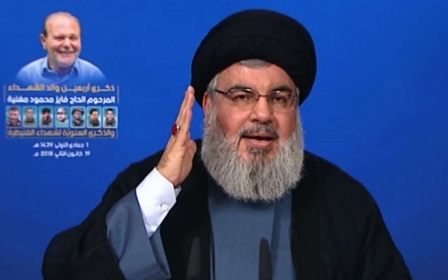'Holy Defence': Hezbollah issues call of duty to video gamers

BEIRUT, Lebanon - Heroic music, gunshots, and street fighting: Holy Defence has all the ingredients of a traditional first-person shooter video game, except this time, the player is a Hezbollah fighter called Ahmad who sets out to defeat Islamic State militants in Lebanon and Syria.
Hezbollah’s latest video game was officially launched in a presentation on Wednesday in Beirut’s southern suburb, the Shia party’s stronghold. Its goal is to glorify the Iranian-backed militia’s intervention in the Syrian civil war by allowing the player to re-create key battles fought since 2013 against Sunni militant groups.
Dozens of DVD copies of Holy Defence, subtitled “protection of the homeland and of holy sites”, were distributed during its presentation.
“This is not just a game,” reads the description at the back of the DVD, “but a tool to confront the violent culture which invades our markets through games devoid of sentiment or sense of belonging”.
The reference to American video games is clear. “They have Call of Duty, Counter Strike, Delta Force…Our game is different, as it is based on real battles”, argues Hassan Allam, who developed the video game. According to him, battle scenes were painstakingly recreated using pictures of where they took place in Lebanon and Syria. The game’s development took two years, which included six months of research.
Designed for Windows and scheduled to be available on Android smartphones within a month, the game can be bought in two points of sale in Lebanon, Dar el-Manar and Dar el-Maaref, for $5 a copy.
Organisers hope to make it available soon all over the country, as well as translate it into English and Persian. However, it will not be easy to download online, as the United States, which considers Hezbollah a terrorist organisation, has issued a series of sanctions in recent years attacking its financial network.
Hezbollah released its first video game in 2000, with “Quds Kid”, followed by “Special Force I”, after Israel’s retreat from Southern Lebanon, and “Special Force II”, based on the 2006 Hezbollah-Israel war, according to Moustapha Khazem, manager of Hezbollah affiliated Al-Ahed news website. The organisers would not communicate how many people bought the previous games, so it’s difficult to estimate how wide this new game’s appeal will be.
“The resistance (Hezbollah) does not just use force to face its enemies. More importantly, it (needs) culture, belonging and identity,” said Mohammad Fneich, one of Lebanon’s two Hezbollah ministers, during a speech at the launch.
“(We) must use technology to influence the minds of young people and teenagers,” he continued.
“I believe we need to re-write the events surrounding why, where and how the resistance entered Syria.”
Defending holy shrines
Holy Defence starts off at the shrine of Sayeda Zeinab, Syria’s holiest Shia site on the southern edge of Damascus, dedicated to the granddaughter of the Prophet Muhammad. In 2013, Hezbollah and Iraqi fighters flocked to defend the shrine from Sunni rebel groups. The shrine, a site of mass pilgrimage for Shia from across the world, has also been the target of several IS attacks.
In June 2016, the group claimed responsibility for suicide and car bomb blasts in which over 20 people died. Another attack in March 2017 killed at least 40 Iraqi pilgrims. According to Reuters, almost every Shia militia fighter bears insignia on his combat fatigues with the words “For your sake, Sayeda Zeinab.”
The main protagonist of the game is Ahmad, who speaks with a Lebanese accent.
It’s a call to their young public to emulate the game, and to take pride in joining the fight
- Waddah Charara, academic
“At first, he visits Sayeda Zeinab as a civilian. But he transforms into a fighter as the takfiri start bombarding it,” said Allam, using a term Hezbollah uses to describe hardline Sunni Muslim groups such as Islamic State
Ahmad then goes on to fight in Al-Hujeira, a town close to Sayeda Zeinab, as well as in Quseir, where Hezbollah fought its first key battle alongside Bashar al-Assad in 2013.
With Hezbollah’s help, Assad was able to retake a key route between the capital Damascus and his stronghold in the Mediterranean coast. Today, thanks to Iranian and Russian backing, only a few pockets of Syria remain outside the government’s control. One of the last rebel-held enclaves is Eastern Ghouta, where continuous bombing has killed hundreds of people in the past few weeks.
In the final stages of the game, Ahmad has to kill the main suspect behind the twin suicide bombing in Beirut’s predominantly Shia Southern suburbs which killed 46 people in November 2015. In real life, the suspect, identified as Abdel Salam Abdel Razzak al-Hindawi, was killed in Syria a few weeks after the Beirut attack during a joint operation by Syrian security forces and Hezbollah, according to Al-Manar.
Holy Defence ends in Lebanon. Ahmad participates in the battle of Ras Baalbek, at the border with Syria, where Hezbollah and the Lebanese army fought an IS enclave last summer. In the game, the yellow Hezbollah flag floats conspicuously alongside the Lebanese one.
To strengthen its unifying message, Hezbollah was particularly keen to stress its support for the Lebanese army during the battle against the militants. On the other hand, the army tried to publicly distance itself from Hezbollah, to not lose support from its international supporters such as the United States.
"The main aim of this game, based on real strategic battles, is to document our victories so that we do not forget the heroes of the resistance,” explained Allam. More importantly, its role is to act as an “international soft power tool”, stresses Khazem, from Al-Ahed website.
The organisers argue that their aim is merely to inform in an interactive manner, and not to recruit new fighters for the party, whose involvement in the Syrian war has transformed it into one of the world’s most powerful militias, with 15,000 to 20,000 men, according to retired Lebanese army general Khalid Helou. Hezbollah does not disclose figures.
But according to Hezbollah expert and sociology professor Waddah Charara, this type of video game goes further than just showing off Hezbollah’s victories.
“It’s a call to their young public to emulate the game, and to take pride in joining the fight," he explained. He estimates that roughly 2,500 Hezbollah fighters have been killed in the war in Syria.
Hezbollah has a “strong tradition of placing its public in battle-like scenes,” added Charara. In South Lebanon, the Mleeta war museum, opened in 2010, features mangled Israeli tanks and rocket launchers.
Tourists can visit underground bunkers and tunnels used by Hezbollah fighters. Similarly, in Maroun Al-Ras park, which was built by Iran, statues of Hezbollah fighters who died fighting have been erected.
“Hezbollah finds all sorts of ways to provide revolutionary tourism to its public,” argues Charara.
New MEE newsletter: Jerusalem Dispatch
Sign up to get the latest insights and analysis on Israel-Palestine, alongside Turkey Unpacked and other MEE newsletters
Middle East Eye delivers independent and unrivalled coverage and analysis of the Middle East, North Africa and beyond. To learn more about republishing this content and the associated fees, please fill out this form. More about MEE can be found here.






